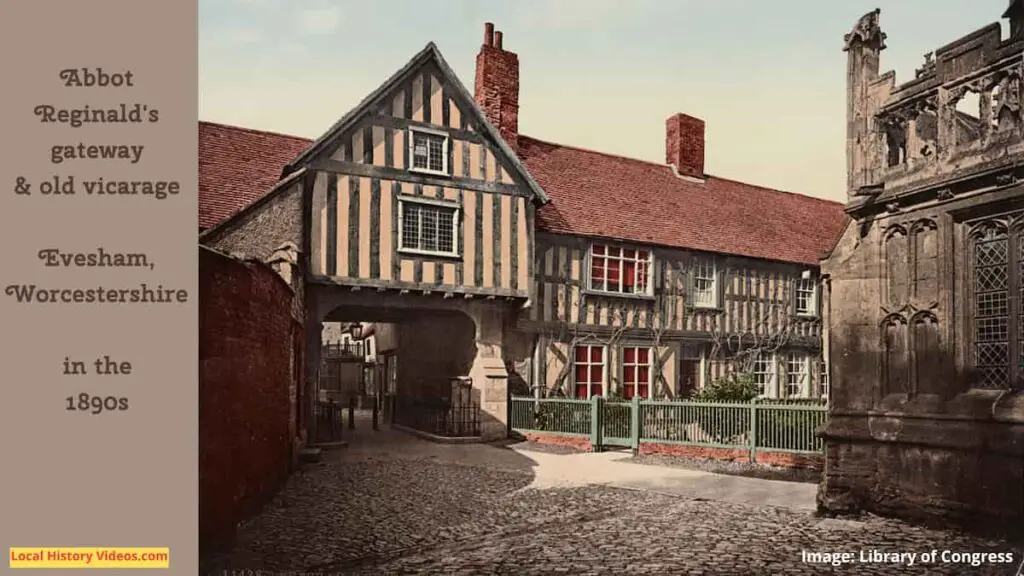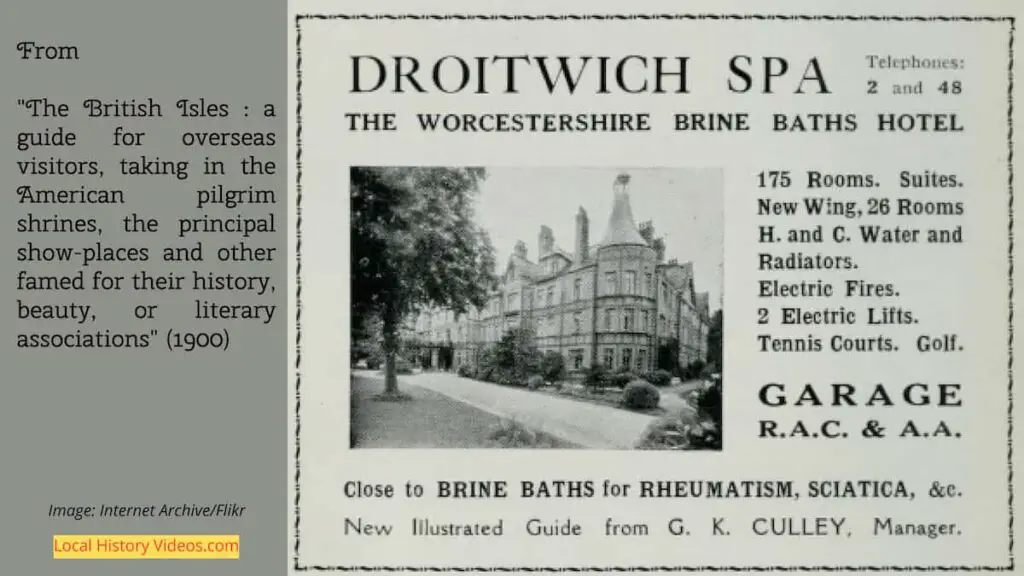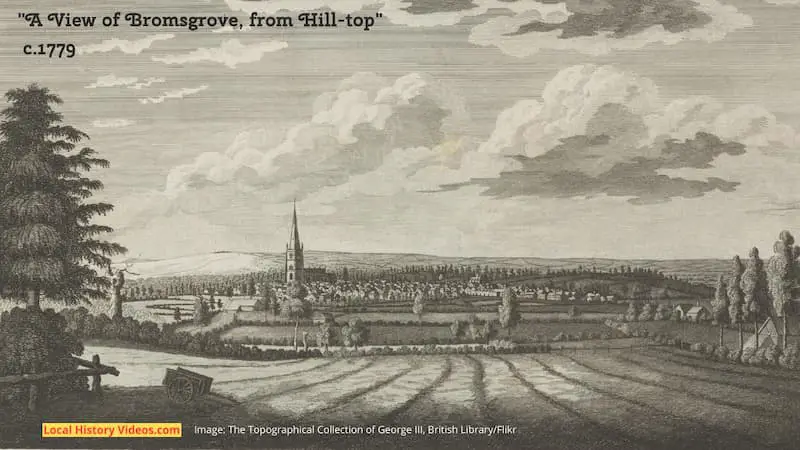Glimpse history through old images of the city of Worcester, Worcestershire, England, UK.
Friar Street
This is an old photo of Friar Street, taken in 1903.
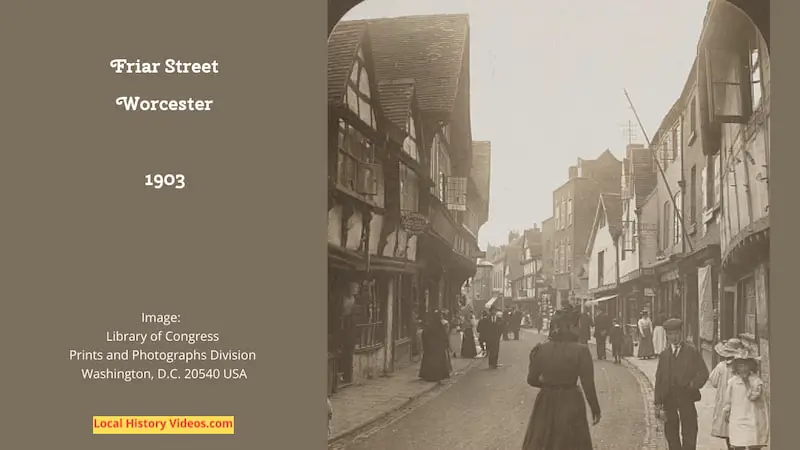
And here’s a closeup with an edited tint, you so can see a bit further down the road.
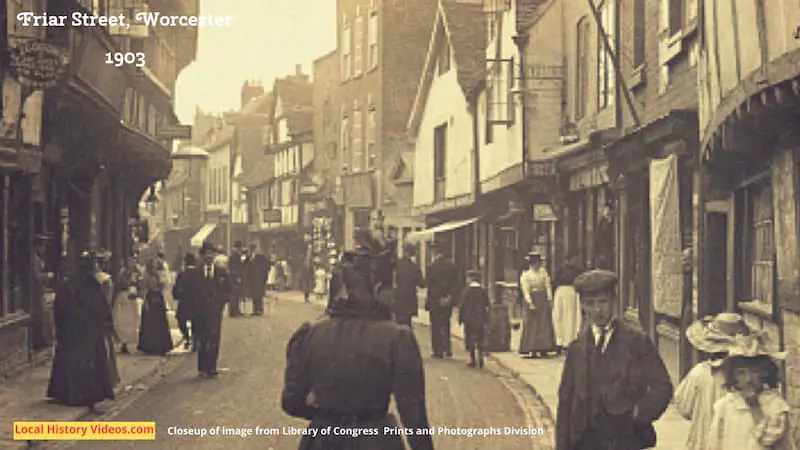
Baldwin’s Freedom of City 1923
In 1923, Stanley Baldwin received the Freedom of the City of Worcester. He attended the Guildhall ceremony with his wife, arriving in a car which also contained the Mayor.
It’s a shame that the clip only shows the briefest of glances of the street beyond, and a hazy one at that. But it’s included here because it was a notable event in the city’s twentieth century history, and it contrasts with the 1950 news item below, when Churchill received the same honour at an event celebrated by the wider community.
Mr Baldwin Freedom Of Worcester (1923) – British Pathé on YouTube
Cathedral Wedding 1939
Lots of local women appear in this newreel about the wedding between Mr Kenneth Noel Findley and Miss Mary Eleanor Bertie Roberts, niece of Honourable Humphrey Pakington.
Worcester Cathedral Wedding (1939)- British Pathé on YouTube
Worcester in 1943
Filmed in 1943, during the Second World War, this short item made for cinema screening shows Worcester’s ancient buildings and key and marks. It also shows the city’s famous porcelain being hand painted.
Worcester (1943) – British Pathé on YouTube
Churchill: Freedom of City 1950
In 1950, Winston Churchill received the Freedom of the City of Worcester in a ceremony held at the Guildhall. Thousands of people lined the streets to welcome him.
It was the 35th Freedom of the City Churchill had received. He was accompanied by his wife. Inside the Guildhall, the ceremony was led by the Mayor, Mr T.S. Bennett, overseen by the unnamed Town Clerk.
Worcester Part Of Political Leaders Busy Weekend (1950) – British Pathé on YouTube
Princess Margaret 1952
The arrival of Princess Margaret at the Guildhall in 1952 brought out large crowds of local people to welcome her.
Special – Princess Margaret In Worcester (1952) – British Pathé on YouTube
Floods 1965
Down in the Severn Valley, the floods covered the fields. Even the Worcester Bridge, completed in 1781, looked as though it would soon be overwhelmed. Ansell’s bar was almost knee deep in water.
River Runs Riot (1965) – British Pathé on YouTube
Worcester Buses
These next two videos are trailers for transport DVDs you can buy. Although they focus on the buses, they also show several different locations, passing cars, pedestrians, and nearby buildings and businesses.
1997:
WORCESTER BUSES 1997 – DaveSpencer32
1998:
WORCESTER BUSES 1998 – DaveSpencer32
A Bit of Worcester History
Extract from the introduction to:
“The Chronicle of Florence of Worcester: With the Two Continuations; Comprising Annals of English History, from the Departure of the Romans to the Reign of Edward I.”
by Florence (of Worcester), John (of Worcester), John de Taxster, translated by Thomas Forester, published by H.G. Bohn.
Published 1854
Pages x-xi
With respect to the authorship of the first Continuation, independently of what may be gathered from a careful examination of the passage in Ordericus, there is internal evidence that it was compiled by a monk of Worcester named John, who was contemporary with the events which he records. One of these circumstances is sufficiently indicated by an entry under the year 1038, in which the writer says,
“Be JOHN corrected, if there aught occur
In which the reader finds his pages err.”
That he was contemporary with the occurrences which he relates appears incidentally from his mode of speaking of King Stephen, where he says: “He was, nay is, at the present moment, desirous of peace.” He mentions Henry de Blois, Bishop of Winchester, and Milo, Earl of Hereford, as living characters from whom he had received certain information, indicating that he had access to the highest sources of intelligence.
The most striking passage in the volume is, perhaps, that in which he paints, as an eyewitness, the fearful scenes which occurred during an assault on Worcester by the partisans of the Empress Maud, when an infuriated rabble burst into the abbey church while he and the rest of the monks were chanting primes in the choir.
Indeed, like his predecessor Florence, he is naturally more diffuse and circumstantial than other chroniclers regarding occurrences connected with Worcestershire, the neighboring counties, and the borders of Wales.
The first Continuation of Florence brings the annals down to the close of the year 1141, the period of Stephen’s captivity after losing the battle of Lincoln. As several of the manuscripts, however, terminate with the year 1131, it has been supposed that the history of the last ten years was the work of another contemporary writer. But so far from there being internal evidence of any such change, the entry in which John, the monk of Worcester, introduces his own name, was inserted as late as 1138. While, therefore, there is no reason to doubt that the original Chronicle is the genuine production of Florence, the authorship of the first Continuation may be safely ascribed to John, the monk of Worcester, who was probably his disciple, and on whom his mantle worthily fell.



